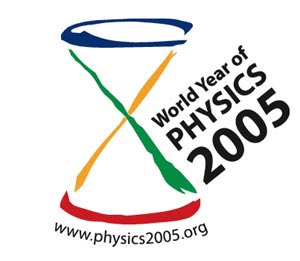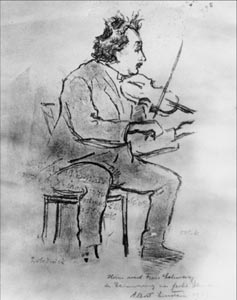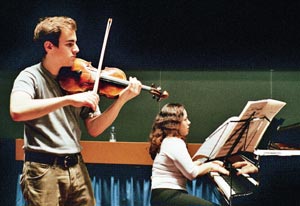The World Year of Physics is upon us, designated Einstein Year in the UK. Brian Foster considers the complex web of connections between two of the famous scientist’s main passions – music and physics.
Music has always seemed to attract physicists, perhaps because its clear and complex mathematical structure is somehow familiar, perhaps because creativity in music is refreshingly different from that in science. This link can be traced back to the ancient Greek philosophers, such as Heraclitus and Pythagoras, who discovered the mathematical basis of harmony and applied it to the movements of the planets.

In modern times at CERN, Vicky Weisskopf (director-general 1961-1964) was a gifted pianist and famously said, “When things get tough, there are two things that make life worth living: Mozart, and quantum mechanics.” One of his successors, Herwig Schopper (director-general 1980-1988), is also a keen pianist. It was music that brought together Jack Steinberger and Konrad Kleinknecht to work on CP violation in the K meson system. Steinberger played the flute and Kleinknecht the violin in the CERN chamber orchestra; over a beer after a rehearsal in 1965 the two agreed to collaborate. The collaboration extended to many memorable chamber-music sessions at Steinberger’s house, involving Heinrich Wahl, Jürgen May, Günther Lütjens, Yves Goldschmidt-Clermont and others.
Kleinknecht also forms a link to another great physicist-musician prominent in the pioneering days of CERN, Werner Heisenberg, a very fine pianist; Kleinknecht was part of a small orchestra brought together to celebrate Heisenberg’s 60th birthday by accompanying him in a performance of Mozart’s Piano Concerto, K488.
Turning specifically to the violin, many physicists, including the author of this article, have been fascinated by it, and found relaxation and fulfilment in playing. Of these, the most famous is Einstein. His violin rarely left his side and he played it often, at an accomplished level, throughout his life, saying that “life without playing music is inconceivable to me”. Max Planck was also a highly gifted pianist, composer and singer. Lise Meitner once remembered a musical evening at the Plancks’ house in Berlin, in which Planck, Einstein and a professional cellist played Beethoven’s Piano Trio in B-flat major. “Listening to this was marvellously enjoyable, despite a couple of unimportant slips from Einstein… Einstein was visibly filled with the joy of the music and smiled in a light-hearted way that he was ashamed of his dreadful technique. Planck stood quietly by with a blissfully happy face and, hand on heart, said ‘That wonderful second movement!’ ”

Image: Emil Orlick/AIP Emilio Segrè Visual Archives.
Einstein was an inveterate concert-goer. He attended the famous debut of Yehudi Menuhin with the Berlin Philharmonic under Bruno Walter, in which the 13-year-old Menuhin was soloist in a programme of the Bach, Beethoven and Brahms concertos that would be nowadays inconceivable. Einstein was so moved by Menuhin’s playing that he rushed into the boy’s room after the performance and took him in his arms, exclaiming “Now I know that there is a God in heaven!” He once said that had he not been a physicist, he would have been a musician: “I often think about music. I daydream about music. I see my life in the form of music.”
The other side of the coin is violinists who have been interested in physics. In the modern age, the well known American violinist, Joshua Bell, has a great interest in physics and has collaborated with physicists and engineers at the Massachusetts Institute of Technology in a project to enhance and expand the violin electronically. There is indeed a curious though tenuous link between Bell and Einstein. The great virtuoso Bronislav Huberman was a friend of Einstein, and visited him at his home in Princeton, no doubt together with his great Stradivarius violin, known as the “Gibson” Strad, made in 1713 during the “golden period” of his work. One day, the Strad was stolen from Huberman’s dressing room at Carnegie Hall in New York. It disappeared and was lost for more than 50 years, during which time the thief played it around the backstreet bars of New York City until he died. In 2001, Bell acquired the “Gibson” for almost $4 million and now uses it as his sole concert instrument.
Given their friendship and mutual interest, it seems likely that Huberman would have allowed Einstein to play this marvellous instrument, providing a link between Bell and Einstein through this great masterpiece of the violin-maker’s art.

Another violinist who is keenly interested in the work of CERN is Jack Liebeck, one of Britain’s outstanding young violinists. Liebeck, who was born in 1980, has been playing the violin since he was eight. He made his first public appearance playing the young Mozart on BBC television at the age of 10. Liebeck plays one of the finest instruments by another great maestro of Italian violin-making, Giovanni Battista Guadagnini. The violin dates from 1785 and is known as the “ex-Wilhemj”.
On 11 October 2004 Liebeck played with Russian pianist Katya Apekisheva in the CERN Auditorium. The occasion was a special gala concert sponsored by the UK Particle Physics and Astronomy Research Council as a tribute to the CERN staff on the organization’s 50th anniversary. In the morning, Liebeck toured CERN and visited the locations where the ATLAS and CMS detectors are being installed for the Large Hadron Collider. The concert that evening featured an electrifying performance of the Prokofiev Sonata No. 1, as well as very fine readings of the Debussy Sonata and Beethoven’s “Kreutzer” Sonata. After a brief tuning-up variation on “Happy birthday to you”, the pair played a beautiful encore: “Vocalise” by Rachmaninov. A further concert in honour of CERN’s 50th anniversary, sponsored by the UK’s Central Laboratory of the Research Councils, was held at the Rutherford Appleton Laboratory in Oxfordshire on 9 December, when Liebeck was accompanied by the British pianist Charles Owen.
Hardly was CERN’s birthday over when an even bigger cause for celebration arrived at the start of 2005 with the World Year of Physics, designated by the Institute of Physics as Einstein Year in the UK. Liebeck is embarking on a world tour giving concerts to celebrate this, and is also accompanying the author on a world lecture tour in which descriptions of Einstein’s universe and modern ideas in particle physics, including superstrings, will be illustrated with demonstrations on Liebeck’s Guadagnini and specially commissioned music from two young British composers, Emily Hall and Anna Meredith. Thus the long tradition of cross-fertilization between physics and music continues.
Einstein’s own words form a fitting conclusion: “I am happy because I want nothing from anyone. I do not care for money. Decorations, titles, or distinctions mean nothing to me. I do not crave praise. The only thing that gives me pleasure, apart from my work, my violin, and my sailboat, is the appreciation of my fellow workers.”








